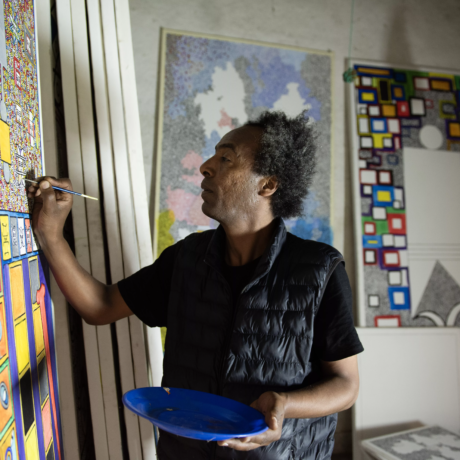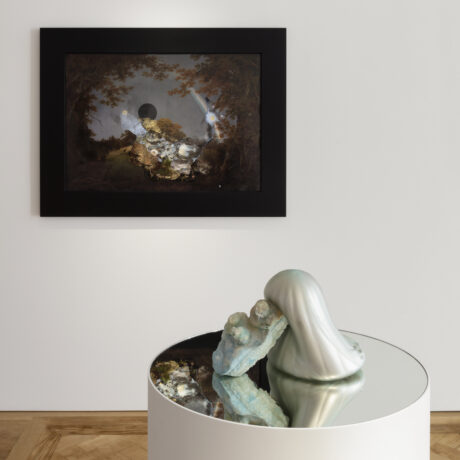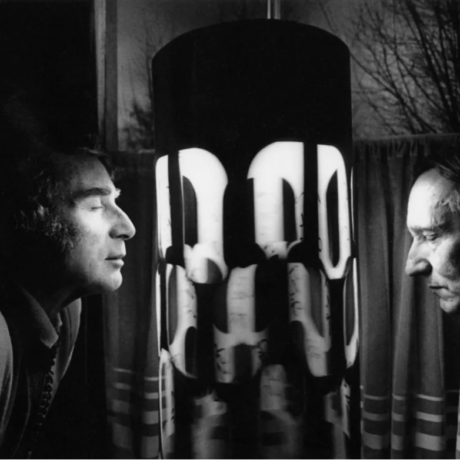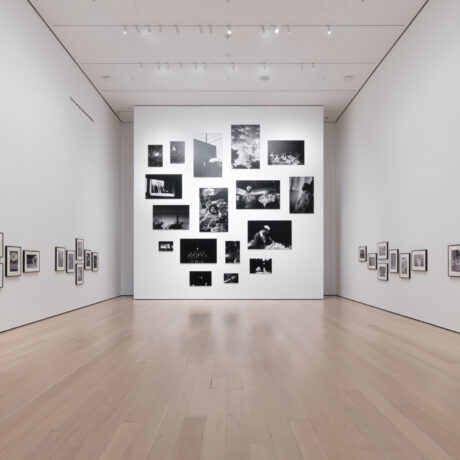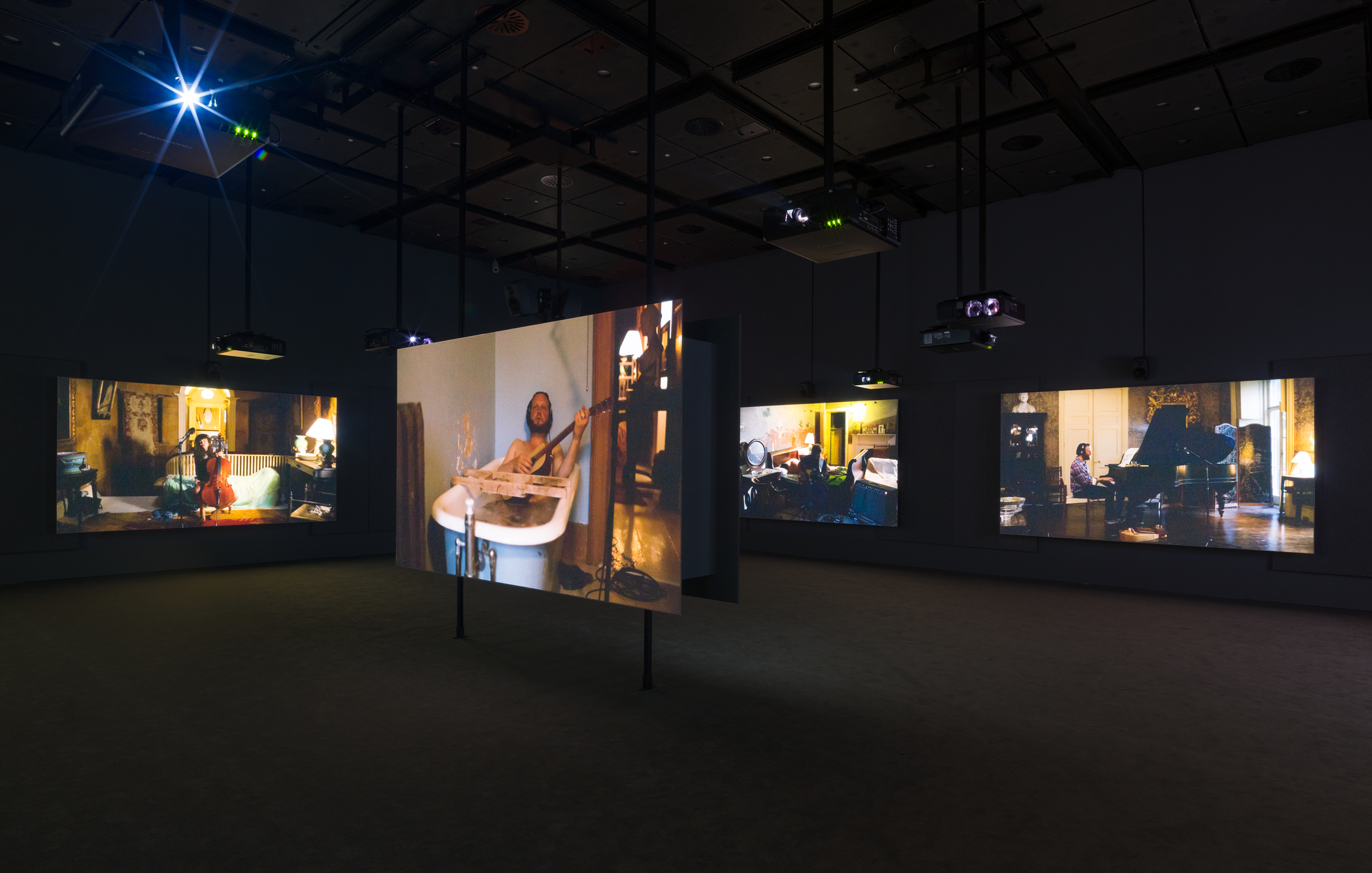
The first time I saw Ragnar Kjartansson’s “The Visitors” was a few months before I was set to finish my graduate studies. I don’t know to what extent I can actually say I stumbled upon a full-room, multi-stream video installation, but I will say that discovering it felt like serendipity. My partner and I were strolling through the Institute of Contemporary Art in Boston and wandered in, just like so many other darkened, curtain-muffled rooms in a museum, not knowing what to expect. And how could we have been prepared?
“The Visitors” consists of nine screens, each of which shows a different room or corner of an old, lightly decayed gem of a manor in upstate New York, the kind of place with generational wear on the wooden furniture and a shabby glamour all its own. Each view becomes populated with a musician—there’s a man switching between a banjo and an electric guitar in a library, a barefoot woman playing the accordion in a slip dress, a bassist in a bedroom, a drummer in the kitchen, a cellist holding court on a chaise lounge on a landing, and of course, Kjartansson himself, playing his guitar from the bathtub. Together, they create a melancholic, looping and iterating song that Kjartansson has called a “feminine nihilistic gospel song.” It’s enormous, enormous art—each screen projects each artist to larger-than-life dimensions. There are, again, eight musicians plus a choir of onlookers singing along from the porch, all looping over each other to form a ladder of sound. A Civil War-era cannon is shot off twice during the course of the performance. It’s also small and human—a woman sleeps in the bed next to the bassist, covered in a green sheet, with her nude shoulder sloping away from the viewer, Kjartansson’s bathtub splashes become their own kind of percussion accompaniment, and two of the musicians in a downstairs parlour take advantage of a break in the music to share a drink and a cigar.
It was, at 26, an overwhelming experience that almost felt like it reflected and magnified my life back to me. I had just spent two years in divinity school, imagining myself as a writer within a community that was supportive and kind and open to both the enormous and the human and made space for both to sit next to each other inside the kind of old ivy-clad buildings a set designer’s dreams are made of. “The Visitors” was an assurance that the world was a place where artmaking could be easy, could fit in seamlessly with friendship and love and long baths, could be as languorous as it was ambitious, as special as it was mundane. And then, the real world hit—I graduated and started working a nine-to-five, worried more about email formatting than writing creative papers, and stayed quiet in weekly meetings instead of batting around an idea across a discussion room. I loved my job, but it was very much a job. And then, nine months later, a global pandemic started, and life felt even farther from “The Visitors” enchanted mansion.
There is, of course, a lot of privilege hiding just beneath the surface of “The Visitors”- the ramshackle estate and the use of it had to come from somewhere, the time off to make music and play around for a week, the cameras, the instruments, the invisible labour behind it all, only lightly gestured at when, at the very end of the piece, when all the musicians have left the house singing and ambling across a golden field, a whistling cameraman invisibly moves from room to room, shutting off the video feeds one by one.
In interviews, Kjartansson (and the rest of the participants) tend to talk about the piece as something of a miracle of logistics and love —that “The Visitors” was only possible at the intersection of the hard work and care of many, many people, and many, many accidents of good fortune.
And that’s exactly where I found myself the next time I saw “The Visitors” some four years later. The week prior, I had quit my job in preparation for the publication of my first book and was mired in anxiety about both things. The finances worked. I had triple-checked the math. I had a hunch the book would open some doors that hadn’t been visible to me before, and I had an idea for a new book—but still. What if the book flopped? What if the money ran out? What if the phone never rang? What if I was lonely? What if I never strung together another two words? What if I hated being a writer every day instead of trying to wedge it in around the edges? I was excited but mostly anxious about whether I’d be able to actually do it.
And then, on a vacation with my mother-in-law and husband, a chance visit to San Francisco’s Museum of Modern Art brought us, once again, into a dark room hung with 9 video screens. And again, with all the serendipity of a message from the universe, there was that grand old house, the eight voices, the shimmering reminder that sometimes, things just work.
In the liner notes to the vinyl release, Canadian poet Anne Carson approaches the task of writing about “The Visitors” in her signature oblique style. In it, she is a misanthrope, puttering about the house in search of her own art, thwarted at every turn by a tumbling band of Icelanders. She writes of this art: “This is what a good drawing does—joining, release from the dead season of oneself.” This is, in fact, the role ‘The Visitors” has played in my own life—as a release from a dead season, as a way to imagine life in a new one. Kjartansson’s view of the artist’s life is utopian, yes—it’s collective and collaborative, harmonious, raucous, joyous, enmeshed with beauty down to the smallest details—but it also includes breakups and melancholy, uncertainty and anxiety. “The Visitors” serves as an invitation to visit—and perhaps stay in—a world where, for at least one golden, late-summer afternoon at a time, it’s all possible.
Words by Alejandra Oliva
